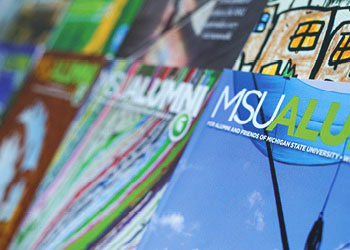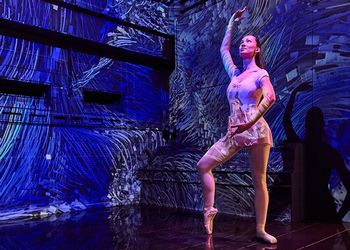Feature: The Spartan Marching Band at 135: Tradition, Innovation, Excellence

You rise at the crack of a Saturday dawn and dress warmly – gloves, scarves and, always, your forest-green wool jacket with the white “Michigan State Band” on the back – to go to morning practice in frosty Spartan Stadium. After a couple of hours running through pregame and halftime shows that have already been honed to perfection, there’s a brief break.
You sprint back to your dorm room to suit up, donning the crisp green-and-white uniform with its snappy military-officer-style hat; you give a final polish to your trumpet or trombone or sousaphone or drum; you thumb through music and marching charts that you know you’ve memorized. You sneak a quick snack that might possibly carry you through the day; you grab your instrument and gallop off to the practice field.
There’s the drum major’s whistle, and then it’s a whirl of cadence and brass and flashing horns as you march to the stadium. You’re playing the Fight Song as you high-step past the Sparty statue, glancing through the corners of your eyes at the crush of fans lining the street.
Then you’re outside the Stadium, and you form up in a concentric huddle surrounding the band director, who leads you in the singing of “MSU Shadows” in four-part harmony. The fans who followed the band hush and listen reverently; some take off their hats. In the background, you can hear the muffled rumble from inside the vast bowl of Spartan Stadium. The thousands are in there, waiting...for the Spartan Marching Band.
You enter the cool darkness of the stadium tunnel, and the adrenaline is really pumping now. Your fellow band members are hopping up and down with excitement; you grasp hands with your squad members and look into each other’s eyes – the Moment is here!
And this is what it comes down to, this Moment that is distilled forever in the minds and hearts of every Spartan Band member. There’s the whistle! The drums thunder the staccato beat of the Spartan kickstep, your legs pick up the motion, and you race toward that brilliant light at the end of the tunnel. Your mouth is open in a yell that combines with 300 other bandsmen’s yells as your feet echo the kickstep rhythm...
Such is the mindset of all alumni of MSU’s famous Spartan Marching Band will recall about “The Moment.”
In its 135 years of existence, the SMB has become an indelible memory not just for its members, but for all Spartans who have attended a sporting event. Whether it’s during a football game at Spartan Stadium, or a band practice at Walter Adams Field, or a Spartan Spectacular concert during Homecoming Weekend, the Spartan Marching Band has clearly become an integral component of the total MSU experience.
Back in 1870, when student and Civil War veteran Ransom McDonough Brooks formed a tiny brass band made up of fellow war vets at Michigan Agricultural College, he could hardly have envisioned what he was starting—that his little ensemble would someday become the dazzling 300-member Spartan Band that entertains thousands of fans every year. MAC itself was only 15 years older than Brooks’ band, having been founded in 1855 as one of the nation’s first land-grant schools. There are no records of what that first band played—probably military-style marches they’d learned as soldier-bandsmen during the bloody “War Between the States.”
These military origins are the core and essence of the Spartan Marching Band and its traditions. A military department was established at MAC in 1885, and the band became an official unit of the college’s Cadet Corps (later the ROTC). Of course, the now-famous colors of green and white were nowhere to be seen—MAC had no official colors (green monograms for intercollegiate athletes were first introduced in 1899), and the band marched in uniforms of gray with black braid, and later army-style khaki. One highlight of that early period was the visit of Theodore Roosevelt to MAC in 1907, with the band leading a grand parade for the President through the streets of East Lansing.
Around the same time—the heyday of march kings John Philip Sousa, Patrick Gilmore and other composers of light brass music—bands across America began to be associated with social and community events, including athletic contests. At MAC, the band members who performed at football games were known as the “Touch-down Band.” And of course, because the college was an agricultural school, “Aggie” was the moniker that became associated with both team and band. A 1912 visit to Ohio State by the MAC band and football team prompted one Columbus newspaper to exclaim, “Never has there been a band on Ohio Field that can compare with the Michigan Aggie.”
THE FALCONE YEARS
The “Aggies” became the Spartans in 1926 (the result of a campus-wide contest to choose a new nickname, the result of which, the resoundingly dull “Michigan Staters,” was ignored by Lansing State Journal sports editor George Alderton, who went with his favorite entry, “Spartans,” and made it stick). That same momentous year, MAC became Michigan State College (MSC). But 1927 would be an equally momentous year—for a young man arrived on the MSC campus who would take the already well-respected band to the heights of national renown.
Leonard Falcone (1899-1985), born in the tiny Italian village of Roseto Valfortore, emigrated to Michigan with his brother Nicholas in 1912 to pursue their mutual passion for music. The brothers Falcone, who had both played in their Italian village band, quickly found work as conductors—Nicholas became director of the University of Michigan’s Varsity Band, and Leonard soon received the call to take over the MSC Band. Thus, for a time, there was a Falcone in charge of both the Michigan and Michigan State bands. In 1935-36, Leonard took it one step further—he took over conducting duties at Michigan for an ailing Nicholas, shuttling back and forth between East Lansing and Ann Arbor for one full year as director of both bands.
Leonard Falcone would eventually be recognized as one of the most famous American university band directors of all time. He led the Michigan State bands for 40 years, from 1927 to 1967. Along the way he saw the school grow from a college of 2,700 to a university of more than 40,000 students. His bands performed at three Rose Bowls, before three more U.S. Presidents (Hoover, FDR and Johnson), and in front of countless thousands of Spartan fans. He was a virtuoso baritone horn player who is still revered by brass musicians worldwide. He introduced open-air band concerts to MSC, conducting before crowds of up to 3,000 in the Art Deco band shell that once stood on the site of today’s Bessey Hall. Under his watch, the marching band, which had spent all its history in military uniform, received its first green-and-white uniforms in 1952—the result of a two-year fundraising drive by students and alumni.
FORGING A NATIONAL REPUTATION
The Michigan State Marching Band, sleek in green and white, drilled and rehearsed to a razor edge by Falcone, truly exploded onto the national scene in 1954. In its first year of Big Ten competition, Michigan State went to the 1954 Rose Bowl, the band traveling to California by train to march in the famous Tournament of Roses parade and perform at the game. Michigan State College became Michigan State University in 1955, and the following January, television audiences across America enjoyed the Spartan Band in the 1956 Rose Parade and in another dazzling Rose Bowl halftime show.
In 1954 the famous “kickstep” was introduced to differentiate MSU’s band from others. It’s a very fast routine, performed at 220 beats a minute, that many other bands have attempted to copy, but without much success. Used when the band makes its entrance, the routine is choreographed in eight-count segments, with horn, knee, and hand accents on counts two and four—a strenuous physical routine that requires practice and conditioning. The Kickstep has emerged as the band’s most distinctive signature item.
The band’s national reputation continued to grow. In 1960, Falcone appointed William Moffit his assistant director. Moffit’s innovative, constantly moving drill routines—which he would trademark as “Patterns in Motion”—swept through the band world, and soon almost every high school and university band in America was influenced by the Michigan State marching style. The Spartan Band was invited to perform at the 1964 New York World’s Fair and in Lyndon Johnson’s 1965 inaugural parade, and made a third Rose Bowl trip in 1966.
Falcone retired in 1967, although he remained active as a clinician and Director Emeritus of Bands until his death in 1985 at the age of 86. Harry Begian, who would go on to a highly respected career as band director at the University of Illinois, took over the MSU Bands from 1967-1970. On the occasion of the Spartan Marching Band’s 100th anniversary in 1970, Kenneth G. Bloomquist became MSU Director of Bands, and throughout the ‘70s he took the band to new heights. He introduced drum-corps-style drills and a color guard – and under his command, women were admitted for the first time, in 1973, to the previously all-male band.
TODAY’S SPARTAN MARCHING BAND
Dave Catron, assistant director under Bloomquist, became director of the Spartan Marching Band in 1979. He expanded the band to 300 members, and further refined its marching and musical style, with spectacular drillwork and forays into rock, Motown, TV and movie music. His tenure was highlighted by MSU’s fourth trip to the Rose Bowl, in 1988, and the Spartan Band winning the Sudler Trophy, the highest honor in the collegiate marching band world.
Under the directorship of John T. Madden since 1989, the MSU Spartan Marching Band continues its upward trajectory. Its watchwords – “Tradition, Innovation, Excellence” – say it all. Time-honored traditions are passed down, year after year, by veteran band members to the freshmen: preseason drill week, military regulations regarding uniform wear, the singing of “Shadows,” the “Series” drum cadence and much more. The band continues to innovate exciting new drill routines, and its repertoire spans styles from Sousa to the Stones, classical music to computer-game soundtracks. And always, always, excellence is the foundation of it all.
This fall, for the 135th straight year, the Michigan State Spartan Marching Band will take the field. And a new group of freshman band members will experience The Moment, now and forever:
Suddenly you burst out of the Stadium tunnel into sunlight and kaleidoscopic color and a deafening wall of sound that smacks you in the face – the roar of more than 70,000 people who are standing up, row upon row up into the heavens, and screaming for you. For the Spartan Marching Band! Horns up, you blast into the State Fanfare, then wheel and spin into the Fight Song as the roar grows impossibly louder. Your hours and hours of rehearsal kick in; you focus your mind on the music and the marching; you block out the crowd and any thoughts except the show.
And then it’s over. You’re off on the sidelines, watching the football team take the field. You walk toward the band seats, looking up at the crowd that’s still on its feet, all green and white and in a fever pitch of excitement that you’ve helped whip up. And you’re exhausted and sweaty and absolutely exhilarated…and you’d do it all again right now if they’d let you.
And you don’t realize it then, but for the rest of your life you will remember all those moments with a crystal clarity – but especially that unique and singular Moment, poised breathlessly there in the tunnel-dark, and the explosion into light and motion and music.
Mary Platt, ’79, M.A. ’86, is public relations editor at Chapman University in Orange County, CA, and has written about arts and entertainment for the Los Angeles Times, Orange County Register and many other publications. She was a member of the Spartan Marching Band trumpet section 1975-1981, and served as publicist for the band, the MSU School of Music and the Wharton Center for Performing Arts until 1991.
SPARTAN MARCHING BAND HISTORICAL HIGHLIGHTS
1855 – Michigan Agricultural College (MAC) founded.
1870 – 10-member brass band formed at MAC by student and Civil War veteran Ransom Brooks.
1885 – Band becomes an MAC Cadet Corps military unit.
1907 – Band performs for President Theodore Roosevelt in East Lansing; A.J. Clark appointed first faculty band director.
1919 – J.S. Taylor becomes band director; “MAC Fight Song” composed by F.I. Lankey.
1926 – MAC becomes Michigan State College; “Spartans” chosen as new nickname for MSC teams.
1927 – Leonard Falcone appointed band director, a position he would keep for 40 years.
1930 – Band performs for President Herbert Hoover at the White House.
1936 – Band performs for President Franklin D. Roosevelt during his visit to Lansing.
1937 – Band shell constructed on campus.
1941-45 – Band remains part of ROTC throughout WWII.
1948 – MSC admitted to Big Ten; SMB introduces “Shadows” as new Alma Mater.
1952 – Band receives its first green-and-white uniforms.
1953 – MSC begins competition in Big Ten; wins football conference title.
1954 – (Jan. 1) Band and team travel by train to Pasadena for Rose Bowl win vs UCLA; band introduces its signature “kickstep” entrance.
1955 – MSC Centennial; MSC becomes Michigan State University.
1956 – (Jan. 1) Band travels to Pasadena for second Rose Bowl appearance and MSU victory vs UCLA
1960 – William Moffit appointed assistant band director; introduces “Patterns in Motion” marching style. Band shell demolished.
1964 – Band performs at New York World’s Fair.
1965 – Band performs in President Lyndon Johnson’s Inaugural Parade in Washington, D.C.
1966 – (Jan. 1) Band flies to Pasadena for its third Rose Bowl appearance.
1967 – Leonard Falcone retires as band director; Harry Begian appointed new director.
1970 – Kenneth G. Bloomquist becomes MSU Director of Bands. Spartan Marching Band celebrates its centennial.
1972 – The first women (a twirler and a saxophonist) are admitted to the previously all-male band.
1975 – First use of drum-corps-style percussion.
1976 – Band adds a Color Guard (flag corps); band performs at its first pro football game (Detroit Lions at the Silverdome).
1979 – Dave Catron named Associate Director of Bands and director of Spartan Marching Band.
1984 – Band delegation performs at World’s Fair in New Orleans. Band performs at World Series (Tigers vs Padres) in Detroit and at first Cherry Bowl in Pontiac.
1985 – Beloved band director emeritus Dr. Leonard Falcone dies. Band performs at All-American Bowl in Birmingham, AL.
1988 – (Jan. 1) Band flies to Pasadena for fourth Rose Bowl appearance and MSU victory over USC. Band is awarded the Sudler Trophy, the highest national honor a collegiate marching band can receive.
1989 – John T. Madden becomes Assistant Director of Bands and marching band director. Band performs at Gator Bowl in Florida.
1990 – Band performs at John Hancock Bowl, El Paso, TX .
1993 – Kenneth G. Bloomquist retires; John Whitwell named Director of Bands. Band members perform at Coca-Cola Bowl in Tokyo, Japan. Band performs at Liberty Bowl.
1995 -- Mary Houhanisin becomes first female drum major. Band performs at Independence Bowl.
1996 – Band performs at Sun Bowl in El Paso.
1997 – Band delegation performs at Aloha Bowl in Hawaii.
2000 – (Jan. 1) Band performs at Citrus Bowl in Orlando.
2001 – MSU and Notre Dame bands combine for tribute to 9-11 victims; band travels to Silicon Valley Bowl in Fresno, CA.



